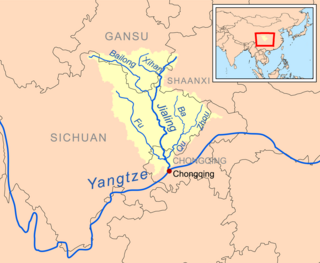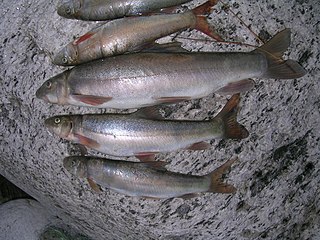
The Yangtze or Yangzi is the longest river in Eurasia, the third-longest in the world, and the longest in the world to flow entirely within one country. It rises at Jari Hill in the Tanggula Mountains of the Tibetan Plateau and flows 6,300 km (3,915 mi) in a generally easterly direction to the East China Sea. It is the fifth-largest primary river by discharge volume in the world. Its drainage basin comprises one-fifth of the land area of China, and is home to nearly one-third of the country's population.

The Chinese paddlefish, also known as the Chinese swordfish, is an extinct species of fish that was formerly native to the Yangtze and Yellow River basins in China. With records of specimens over three metres and possibly 7 m (23 ft) in length, it was one of the largest species of freshwater fish. It was the only species in the genus Psephurus and one of two recent species of paddlefish (Polyodontidae), the other being the American paddlefish. It was an anadromous species, meaning that it spent part of its adult life at sea, while migrating upriver to spawn.

The Sichuan Basin, formerly transliterated as the Szechwan Basin, sometimes called the Red Basin, is a lowland region in southwestern China. It is surrounded by mountains on all sides and is drained by the upper Yangtze River and its tributaries. The basin is anchored by Chengdu, the capital of Sichuan province, in the west, and the direct-administered municipality of Chongqing in the east. Due to its relative flatness and fertile soils, it is able to support a population of more than 100 million. In addition to being a dominant geographical feature of the region, the Sichuan Basin also constitutes a cultural sphere that is distinguished by its own unique customs, cuisine and dialects. It is famous for its rice cultivation and is often considered the breadbasket of China. In the 21st century its industrial base is expanding with growth in the high-tech, aerospace, and petroleum industries.

The Jialing River, formerly known by numerous other names, is a major tributary of the Yangtze River in the Sichuan Basin. It is named after the Jialing Valley in Feng County, Shaanxi through which it flows.

Oncomelania hupensis is a species of very small tropical freshwater snail, an aquatic gastropod mollusk in the family Pomatiopsidae.
The Ziliujing Formation is a geological formation in China, It is Early Jurassic in age. It is part of the stratigraphy of the Sichuan Basin. The dinosaur Gongxianosaurus and indeterminate theropod material are known from the Dongyuemiao Member of the formation, as well as dinosaur footprints, Zizhongosaurus and indeterminate prosauropods from the Da'anzhai Member. The basal sauropod Sanpasaurus is known from the Maanshan Member. An unnamed stegosaur and the pliosauroid plesiosaur Sinopliosaurus are also known from this formation but they were found an indeterminate member. An unnamed teleosaurid known from a complete skull has also been found in the formation, pending a formal description. The deposition environment during the Da'anzhai Member in the lower Toarcian is thought to have been that of a giant freshwater lake encompassing the whole of the Sichuan basin, around 3 times larger than Lake Superior, coeval with the Toarcian Oceanic Anoxic Event around 183 Ma.

Schizothorax is a genus of cyprinid fish found in southern and western China, through northern South Asia (Himalaya) and Central Asia, to Iran, with a single species, S. prophylax, in Turkey. They are primarily found in highland rivers, streams and lakes, although a few species occur in lower-lying locations, like Lake Balkhash and lakes of the Sistan Basin. Their scientific name means "cloven-breast", from Ancient Greek schízeïn (σχίζειν) 'to cleave' and thórax (θώραξ) 'breast-plate'. The western species are typically referred to as marinkas from their Russian name marinka (маринка), while the eastern species are usually called snowtrout. Although they do resemble trouts in habitus this is merely due to convergent evolution and they are by no means closely related apart from both being Teleostei: Cyprinids are in the teleost superorder Ostariophysi, while trouts are in the superorder Protacanthopterygii. Their ancestors must thus have diverged as early as the Triassic, more than 200 million years ago.

Dabry's sturgeon, also known as the Yangtze sturgeon, Chiangjiang sturgeon and river sturgeon, is a species of fish in the sturgeon family, Acipenseridae. It is endemic to China and today restricted to the Yangtze River basin, but was also recorded from the Yellow River basin in the past. It was a food fish of commercial importance. Its populations declined drastically, and since 1988, it was designated an endangered species on the Chinese Red List in Category I and commercial harvest was banned. It has been officially declared extinct in the wild by the IUCN as of July 21, 2022.
Neosalanx tangkahkeii, the Chinese icefish or short-snout icefish, is a species of icefish endemic to fresh and brackish waters in China. Despite its common name it is not the only icefish in China; the majority of the species in this family are found in the country.

Lenoks, otherwise known as Asiatic trout or Manchurian trout, are salmonid fish of the genus Brachymystax, native to rivers and lakes in Mongolia, Kazakhstan, wider Siberia, Northern China and Korea.
Schizothorax chongi is a species of ray-finned fish in the genus Schizothorax from the upper parts of the Yangtze basin in China.
Schizothorax cryptolepis is a species of cyprinid fish in the genus Schizothorax from the upper parts of the Yangtze basin in China.
Schizothorax dolichonema is a species of ray-finned fish in the genus Schizothorax from the upper parts of the Yangtze basin in China.
Schizothorax griseus is a species of ray-finned fish in the genus Schizothorax. It is found in the basins of the Yangtze River basin, the upper Pearl River and the upper Mekong River in southern China.
Schizothorax heterochilus is a species of ray-finned fish in the genus Schizothorax from the upper parts of the Yangtze basin in China.
Schizothorax sinensis is a species of ray-finned fish in the genus Schizothorax from the middle and upper parts of the Yangtze basin in China.
Schizothorax wangchiachii is a species of ray-finned fish in the genus Schizothorax from the upper parts of the Yangtze basin in China.

The Shudao, or the Road(s) to Shu, is a system of mountain roads linking the Chinese province of Shaanxi with Sichuan (Shu), built and maintained since the 4th century BC. Technical highlights were the gallery roads, consisting of wooden planks erected on wooden or stone beams slotted into holes cut into the sides of cliffs.
The Xintiangou Formation is a geological formation in China. Part of the stratigraphy of the Sichuan Basin, it is of an uncertain Middle Jurassic age, with preliminary U-Pb estimates giving an age range of 170 ma. It predominantly consists of interbedded mudstone and sandstone, with subordinate shelly limestone. At the Laojun site remains of lungfish, bony fish, freshwater sharks, temnospondyls, sauropterygians, crocodyliformes, the Xinjiangchelyid turtle Protoxinjiangchelys and tritylodontids are known. The dinosaurs Sanxiasaurus,Yunyangosaurus, and indeterminate sauropods are also known from the formation. Theropod and ornithopod tracks have also been reported from the formation.









